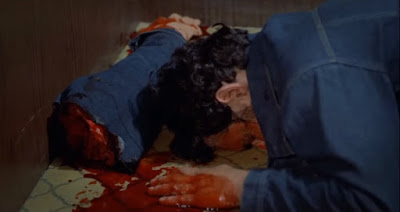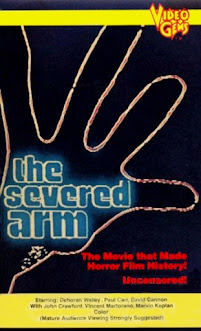... aka: A Vingança Será Minha (Revenge Will Be Mine)
... aka: Brazo asesino (Killer Arm)
... aka: La grande paura (The Big Fear)
... aka: Los mutilados (The Mutilated)
... aka: Nightmare in Garden City
Directed by:
Thomas S. Alderman
A group of six middle-aged friends: Police detective Mark Richards (Paul Carr), TV writer Jeff Ashton (Paul G. Cannon, also the associate producer), Jewish radio DJ "Mad Man" Herman (Marvin Kaplan), Dr. Ray Sanders (John Crawford), building contractor Bill Hale (Vince Martorano) and Ted Rogers (Ray Dannis), descend into an old mine shaft to "collect rock samples." Due to some ill-advised hammering at the sides of the mine, there's a cave-in that closes off their one and only exit. There's an additional problem other than the obvious: The men are out there in the middle of nowhere as part of a two week camping trip and no one's going to be expecting them home any sooner than that. They also didn't bring along any food and only have a limited supply of water.
Seven days pass... and then two weeks... and then they completely run out of water. As the men start to weaken and wither away, a difficult decision must be made. Based on an old story he remembers about stranded sailors and how they managed to survive sixty days under similar conditions, Jeff suggests they resort to cannibalism. The plan is not to kill one of them, but only take a piece off at a time as needed. The meal supplier will even get to choose which part of his body he's willing to sacrifice. They draw strips of paper and Ted ends up with the shortest one. After he freaks out and convinces the others to hold out a little longer, Ted loses it and attempts to kill Herman while he's sleeping. The men then pin him down and cut off his arm with a cauterized knife. Just seconds later, and before they even have a chance to eat the arm, they're rescued. Oops!
The men concoct a lie to tell the authorities: Their newly de-limbed buddy's arm was crushed in the cave-in and had to be removed. As Ted is being hauled away on a stretcher, he leaves them with a not-so-veiled threat: "I won't forget."
Five years pass and the men have all moved on with their lives and careers. Well, except for Ted, who ended up having to be put in a mental institution. Jeff receives a package in the mail, which contains a severed human arm removed from a corpse in the morgue. That gruesome special delivery just so happens to coincide with Ted's release from the institution. Rightly sensing that's a sign of things to come, Jeff and Ray get back into contact with the three others to discuss what to do. It's agreed they will pay Ted and his family a visit at their home to mend fences. Before they can, someone armed with a hatchet sneaks inside Ray's home, attacks him and chops off his arm. The psycho then hits Jeff over the head while he's showering and writes "Next" in shaving cream on his bathroom mirror.
Jeff and Detective Mark head out to Ted's place, where they're greeted by Ted's adult daughter, Teddy (former Gidget and Beach Party star Deborah Walley). She claims she hasn't even seen him since his release, that her mother is ill and that her brother, Roger (Bob Guthrie), moved to the opposite side of the country as soon as he finished high school. However, she insists her father, wherever he may be, is innocent and couldn't possibly have done what they're accusing him of. After they take her to see Ray, who's in critical condition in the hospital, she agrees to help them uncover who the culprit is. But time is running out as each of the men is stalked and murdered after being threatened over the telephone.
This movie is clearly uneven when it comes to the performances, plotting (including some clumsily-handled mystery elements) and pacing, but I still ended up enjoying it, anyway. There are some well-done horror sequences in here, especially the bits at the radio station and one taking place in an elevator, good use over-lighting for shadow-casting purposes and a very interesting and offbeat electronic score from Phillan Bishop, who provided the same for the memorable MESSIAH OF EVIL (1973). The finale is amusingly warped and this is also historically interesting as a proto slasher due to the amount of stalking scenes, feet tracking scenes, fetishistic weapon-brandishing shots, gratuitous killer POV shots and the killer's amazing ability to seemingly teleport all over the place from one scene to the next.
Speaking of the killer, he / she does take some getting used to. I couldn't quite figure out if they were being sadistic and intentionally toying with victims prior to murdering them or flat out incompetent since they take forever to actually kill anybody! After popping out of the darkness to chop multiple characters (Ray, Jeff, Mark...) in many different sequences, it takes an entire hour for anyone to actually die!
Adding additional interest is the fact this is the earliest film I've seen that uses the whole "The call is coming from the other line inside your house!" plot device and it does it a full year before it was more famously used in Bob Clark's BLACK CHRISTMAS (1974) and four years before Fred Walton's short The Sitter (1977); the basis for his later film When a Stranger Calls. I was curious about this particular trope and how it came to be and discovered it may have first been used in the 1971 short Judson's Release, which was made by Terence H. Winkless while he was still a film student at USC. I looked everywhere and was unable to find this short to verify the claim but apparently it, as well as other USC shorts from directors like John Carpenter and Dan O'Bannon, are going to be included in a documentary called Shock Value: The Movie.
Certainly a very well-distributed and easy-to-find title, this has received numerous releases over the years. However, you have to be careful which version you get as there are several different cuts on the market. The first is a censored edit prepped for U.S. television, which was used for most of the early American VHS (Congress Video Group, Star Classics) releases, as well as most of the bargain DVD releases from companies like Brentwood (included as part of their 4 movie release "Flesh Feast"), Alpha (who've paired it with the 1977 TV movie Good Against Evil) and Rogue Video. Even the initial restored 2012 DVD release from Code Red, who paired with So Sad About Gloria (1973) as part of their "Maria 'B' Movie Mayhem" line, was missing some footage. That leaves the 1981 VHS release from Video Gems as the only uncut, uncensored U. S. release of the film until the 2020 Blu-ray release from Vinegar Syndrome.
In addition to that there were at least two German VHS releases under two different titles: Nightmare in Garden City on the Vegas Video label, and Amputiert - Der Henker der Apokalypse / "Amputated: The Hangman of the Apocalypse" on the Starlight Video label. The uncut German DVD release from CMV Laservision retains the latter title and artwork.
Director Alderman and his co-scripter, Darrel Presnell, had previously worked on soft-core sex movies like The Master-Piece! (1969) and Coed Dorm (1971), which also featured Dannis and Guthrie. It was based on a story co-written by Marc B. Ray, who'd previously written, directed and produced SCREAM BLOODY MURDER (1972) and eventually moved on to a more wholesome line of work writing for The New Mickey Mouse Club and Kids Incorporated.
★★1/2










































































